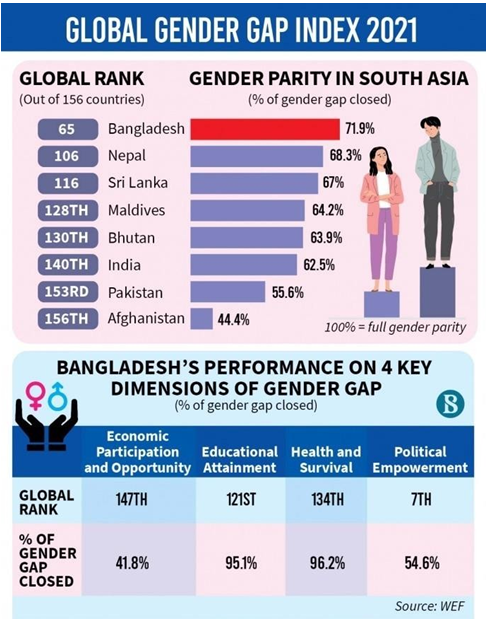Global Gender Gap Report
ABOUT
- It was first published in 2006 by the
- It benchmarks 156 countries on their progress towards gender parity in four dimensions:
- Economic Participation and Opportunity,
- Educational Attainment,
- Health and Survival and
- Political
- Over the Index, the highest possible score is 1 (equality) and the lowest possible score is 0 (inequality).
Aim:
- To serve as a compass to track progress on relative gaps between women and men on health, education, economy and Through this annual yardstick, the stakeholders within each country are able to set priorities relevant in each specific economic, political and cultural context.
India’s Position:
Overall Ranking:
- India is now one of the worst performers in South Asia, it is now ranked 140 among 156 countries.
- In South Asia, Bangladesh ranked 65, Nepal 106, Pakistan 153, Afghanistan 156, Bhutan 130 and Sri Lanka
- India had ranked 112th among 153 countries in the Global Gender Gap Index
Political Empowerment:
- India has declined on the political empowerment index as well by 5 percentage points, and a decline in the number of women ministers, from 23.1% in 2019 to 9.1% in 2021.
- However, it has still performed relatively well compared to other countries, ranking at 51 in women’s participation in
Education Attainment:
In the index of education attainment, India has been ranked at
Economic Participation:
- The report notes that the economic participation gender gap actually widened in India by 3% this
- The share of women in professional and technical roles declined further to 2%.
- The share of women in senior and managerial positions also is at 6% and only 8.9% firms in the country have top female managers.
- The estimated earned income of women in India is only one- fifth of men’s, which puts the country among the bottom 10 globally on this
- In Pakistan and Afghanistan, the income of an average woman is below 16% of that of an average man, while in India it is 7%.
Health and Survival index:
- On this India has fared the worst, ranking at The only country to have fared worse is
- The report points to a skewed sex ratio as the major
- It says the ratio can be attributed to norms of son preference and gender-biased prenatal sex-selective
- China and India together account for about 90 to 95% of the estimated 1.2 to 1.5 million missing female births annually worldwide due to gender-biased prenatal sex selective India has fallen 28 places in the World Economic Forum’s (WEF) Global Gender Gap Report 2021
- Beti Bachao Beti Padhao, One Stop Centre (OSC) Scheme, Ujjawala Scheme are some the initiatives launched by the government to address the issue of gender
- Further, the principle of gender equality is enshrined in the Indian Constitution in its Preamble, Fundamental Rights, Fundamental Duties and Directive

